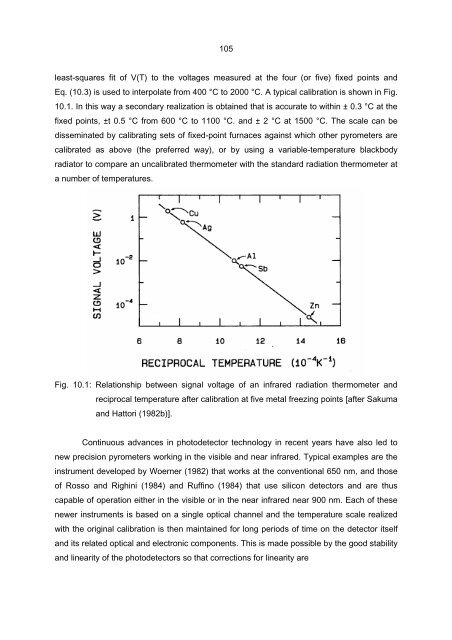techniques for approximating the international temperature ... - BIPM
techniques for approximating the international temperature ... - BIPM
techniques for approximating the international temperature ... - BIPM
You also want an ePaper? Increase the reach of your titles
YUMPU automatically turns print PDFs into web optimized ePapers that Google loves.
105<br />
least-squares fit of V(T) to <strong>the</strong> voltages measured at <strong>the</strong> four (or five) fixed points and<br />
Eq. (10.3) is used to interpolate from 400 °C to 2000 °C. A typical calibration is shown in Fig.<br />
10.1. In this way a secondary realization is obtained that is accurate to within ± 0.3 °C at <strong>the</strong><br />
fixed points, ±t 0.5 °C from 600 °C to 1100 °C. and ± 2 °C at 1500 °C. The scale can be<br />
disseminated by calibrating sets of fixed-point furnaces against which o<strong>the</strong>r pyrometers are<br />
calibrated as above (<strong>the</strong> preferred way), or by using a variable-<strong>temperature</strong> blackbody<br />
radiator to compare an uncalibrated <strong>the</strong>rmometer with <strong>the</strong> standard radiation <strong>the</strong>rmometer at<br />
a number of <strong>temperature</strong>s.<br />
Fig. 10.1: Relationship between signal voltage of an infrared radiation <strong>the</strong>rmometer and<br />
reciprocal <strong>temperature</strong> after calibration at five metal freezing points [after Sakuma<br />
and Hattori (1982b)].<br />
Continuous advances in photodetector technology in recent years have also led to<br />
new precision pyrometers working in <strong>the</strong> visible and near infrared. Typical examples are <strong>the</strong><br />
instrument developed by Woerner (1982) that works at <strong>the</strong> conventional 650 nm, and those<br />
of Rosso and Righini (1984) and Ruffino (1984) that use silicon detectors and are thus<br />
capable of operation ei<strong>the</strong>r in <strong>the</strong> visible or in <strong>the</strong> near infrared near 900 nm. Each of <strong>the</strong>se<br />
newer instruments is based on a single optical channel and <strong>the</strong> <strong>temperature</strong> scale realized<br />
with <strong>the</strong> original calibration is <strong>the</strong>n maintained <strong>for</strong> long periods of time on <strong>the</strong> detector itself<br />
and its related optical and electronic components. This is made possible by <strong>the</strong> good stability<br />
and linearity of <strong>the</strong> photodetectors so that corrections <strong>for</strong> linearity are
















